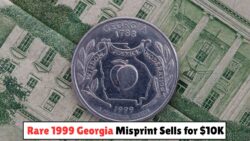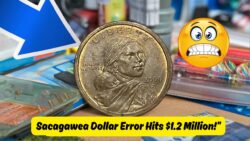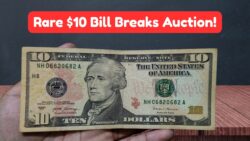1928 Blue Seal $5 Bill – In an astonishing turn of events, a rare 1928 Blue Seal $5 bill has been discovered in circulation, reigniting interest among currency collectors and antique investors. These historic bills, issued nearly a century ago, carry significant historical value and are sought after for their scarcity, design, and unique seal. What’s even more exciting is that some of these rare notes can command up to $8,500 or more in the collector market depending on their condition and serial number. If you’ve stumbled upon an old $5 bill with a blue seal, don’t rush to spend it. That worn-out-looking currency might be a hidden treasure waiting to change your financial fortunes.
What Is a 1928 Blue Seal $5 Bill?
The 1928 Blue Seal $5 bill is part of the U.S. Silver Certificate series. These bills were backed by silver reserves and could once be redeemed for actual silver dollars. Today, they represent an iconic piece of American financial history.
Key Characteristics of the 1928 $5 Blue Seal Note:
- Series Year: 1928
- Seal Color: Blue (indicating a silver certificate)
- Portrait: Abraham Lincoln
- Signatures: Vary by issuing series
- Serial Numbers: Important for collector value
- Size: Smaller modern-size note (unlike earlier large-size bills)
Collectors and dealers value these bills not just for their age but for rarity, serial uniqueness, and condition.
 This 1999 Georgia Quarter With Misprint Just Hit $10,000 at Auction – Still in Circulation!
This 1999 Georgia Quarter With Misprint Just Hit $10,000 at Auction – Still in Circulation!
Types and Series Variants of the 1928 Blue Seal $5 Bill
There are multiple variants in the 1928 $5 Silver Certificate lineup. Each has different values depending on market availability and condition.
| Series Variant | Seal Color | Value in Circulation | Value in UNC Condition |
|---|---|---|---|
| 1928 | Blue | $30–$60 | Up to $450 |
| 1928A | Blue | $40–$80 | Up to $700 |
| 1928B | Blue | $50–$100 | Up to $900 |
| 1928C | Blue | $60–$150 | Up to $1,200 |
| 1928D | Blue | $100–$250 | Up to $2,000 |
| 1928E | Blue | $150–$300 | Up to $3,500 |
| Star Notes | Blue | $200–$800 | $5,000 to $8,500 |
What Makes the $5 1928 Bill Worth $8,500?
Just because it’s from 1928 doesn’t guarantee high value. Certain factors can skyrocket the worth of a bill:
Factors That Increase Value:
- Star Symbol: A star before the serial number boosts rarity.
- Low Serial Numbers: Numbers like 00000025 or palindromes attract premium.
- Uncirculated Condition: Crisp, clean, and no folds or stains.
- Historical Significance: Issued under specific Treasury Secretaries.
- Printing Errors: Misprints, double seals, or off-centers can add thousands.
If all these combine in one note, its auction value can exceed $8,000, especially in numismatic communities or international markets.
How to Identify an Authentic 1928 Blue Seal Note?
Spotting a real 1928 Blue Seal $5 note isn’t difficult once you know what to look for.
- Look for a bright blue seal on the right side of the bill.
- The serial number should match the font and printing style of that era.
- Examine the paper quality; old silver certificates have a distinctive feel.
- Check for a star symbol before the serial number.
Common Mistakes to Avoid:
- Don’t confuse it with the more common 1934 series.
- Faded green seals are usually Federal Reserve Notes, not silver certificates.
- Modern reproductions or “souvenir copies” have “replica” written on them.
Where Can You Sell a 1928 $5 Blue Seal Bill?
If you have this rare note, don’t just visit your local bank. Specialized avenues can fetch you a much higher value.
Trusted Selling Options:
- eBay Auctions – Great platform if you have solid feedback and good images.
- Heritage Auctions – Professional numismatic auctions for rare currency.
- Currency Dealers – Certified professionals who appraise and purchase old money.
- Coin & Currency Shows – Direct buyer interaction for better deals.
- Online Collector Forums – Communities like CoinTalk or Reddit r/papermoney.
Be sure to get your note professionally appraised before selling. This will prevent undervaluing and scams.
Tips to Preserve Your Rare Blue Seal Bill
Preservation is key to maintaining or increasing the value of your bill.
- Avoid Folding: Folds can drop value by hundreds.
- Use a Currency Sleeve: Store it in acid-free, transparent sleeves.
- Keep Away from Light: UV light fades inks and weakens paper.
- No Washing or Ironing: Cleaning damages authenticity.
- Avoid Writing on It: Any mark ruins collector interest.
Is It Still Legal Tender or Only for Collectors?
Technically, yes — you can still use a 1928 $5 bill as legal tender. But doing so would be like throwing away a winning lottery ticket.
- It’s best viewed as a collector’s item, not for regular transaction.
- Many bank tellers today may not even recognize its true value.
- Always keep such historic bills out of general circulation.
You never know what forgotten note might turn out to be a collector’s jackpot. The 1928 Blue Seal $5 bill is a perfect example of how something ordinary can hold extraordinary value. Whether you’re a passionate collector or just someone with an eye for unique finds, this is your cue to check your wallet, drawer, or attic stash for overlooked vintage currency. Who knows — your next $5 bill might just be worth $8,500!
FAQs of 1928 Blue Seal $5 Bill
Q1. What is a 1928 Blue Seal $5 bill?
A1. It is a silver certificate issued by the U.S. Treasury in 1928, with a blue seal and Abraham Lincoln’s portrait.
Q2. Are these bills still valid for use?
A2. Yes, they are technically legal tender, but using them is not recommended due to their collector value.
Q3. How can I tell if my 1928 $5 bill is valuable?
A3. Look for star notes, uncirculated condition, low serial numbers, or printing errors.
Q4. Where can I sell my 1928 Blue Seal note?
A4. Online auctions, currency dealers, coin shows, and numismatic forums are ideal.
Q5. How much can a rare 1928 $5 bill sell for?
A5. Depending on rarity and condition, it can fetch between $30 and $8,500 or more.





